ALLIGATOR
BEHAVIOR page 6d: ON LAND; WALKING AND BASKING page 4 page 1 2
3 5 6
7 8
9 10
This
page was born 10/20/2006. Rickubis designed it. (such as
it
is.) Last update: 7/14/2015
Images
and contents on this page copyright ©2002-2015 Richard M.
Dashnau
Alligators
although amphibious (not AMPHIBIANS) are in the water most of
the time
when they are active. Therefore it is worthy of note when they are
on land, especially
when they are doing more than just absorbing solar
energy. Here is yet another page of terrestrial alligator
antics.
On May
17,
2004, I'd taken a day off and had
gone
to BBSP. The Brazos River was possibly going to flood, due to
heavy rainfall
north and west. As I was at the park, water from Big Creek
and the Brazos
River was already starting to backflow
into
the park. As a result of this, and the rain we'd already gotten,
many of
the small "islands" that the alligators had been basking on
were under
water. So, alligators and other animals were actively crossing the
trails.
---- -----
-----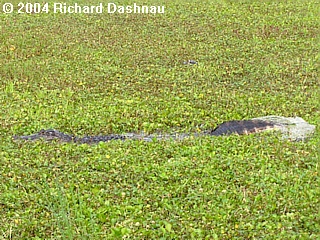 ------
-
------
-
THE TOWER
GUARD
TAIL SWISHING
The
alligator above (TOWER GUARD) was directly across the trail. When
I approached,
it started towards 40 Acre Lake, on the right, then turned
around
and went back into Pilant Lake,
to the left. I'd heard an alligator
headslap in 40 acre lake, and a little later, a large alligator
was chasing
around a smaller one, and generally showing agitation (tail
swishing and
chasing).
For
a picture of this aggressive alligator, see TAIL SWISHING, above
(or see
this video
clip 505kb).
This was going on only about 12 feet from where the alligator was
on the
trail.
May 23,
2004Not
too far from Brazos Bend State Park is a golf course that I pass
on the
way home. Today, I looked at the water trap as I often do. I've
spotted
an alligator in there from time
to time. This time, I noticed a medium-sized
alligator-about 5 feet long, maybe-up on the bank of the trap. I
drove
past, then, decided to turn around and take a picture or two. I
pulled
off the
road, and rolled down the window. As I inched the car forward to
get a good position for a picture, the alligator opened its mouth.
I reached
for the camera, took it out of the case, and turned
it on. While I was
doing all this, the alligator got up and started high walking away
from
me! By the time I got the camera up and focused, the alligator had
topped
the high point and was
heading back down (the pond is U-shaped and the
alligator walked across the center.). Meanwhile, the golfers
seemed oblivious
to their spectator. The pictures below (NOT TIGER...
ALLIGATOR, and
GOLFBALL RETRIEVER) shows the alligator after a few more steps.
After this,
it was out of sight on the rear of the bank. I don't think this is
the
sort of thing you'd expect
at a golf course.
---------------------- ------------------
------------------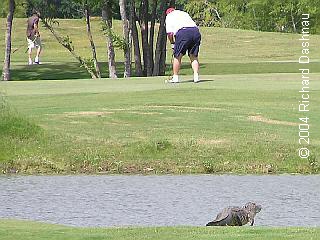
NOT TIGER--ALLIGATOR ON THE
COURSE
GOLFBALL
RETRIEVER
December
12, 2004
Here it is, mid-December, and alligators are sunbathing in the
park. In
a few days, temperatures are supposed to drop to near freezing,
though.
I enjoyed the day even
more with that in mind.
The
RICKUBISCAM image shows one of many alligators that appeared on
various
banks and trails today.
The
alligator in today's RICKUBISCAM is assumed to be the same one
that ate
the turtle Dec. 12 (see pictures below). I stayed near this
alligator for
quite some time. As I watched him (I
assume it's male, for a number of
reasons, but I can't be sure) he started to gape slightly. This is
generally
considered to be a heat-regulating behavior. From personal
observation,
I've
learned that when an alligator begins gaping for long periods
(10-15
minutes or longer), or closes its mouth, but immediately opens it
again,
then the alligator is soon headed for the water.
This large one also followed
this behavior, first by turning headfirst towards the water (body
perpendicular
to bank, instead of parallel as shown), and then, about 10 minutes
later,
slid into
the water. While this big one (about 9 feet long or so) was
gaping,
I was able to get some good pictures. I'm using a camera with a
10x optical
zoom...so I really wasn't very close. Do NOT
ever approach an alligator.
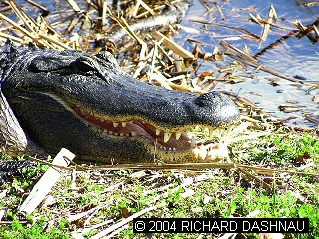 -
-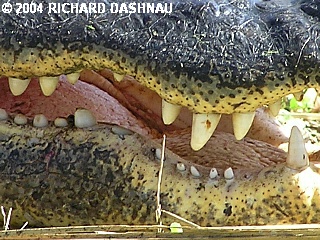 -
-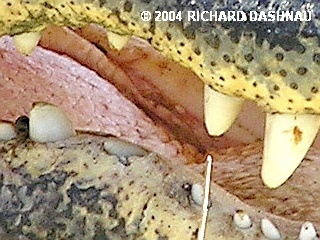 -
-
HEAT EXCHANGE GAPE
TEETH MISSING
NEW TEETH COMING OUT
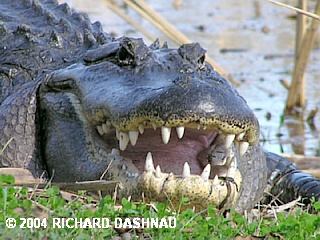 -
-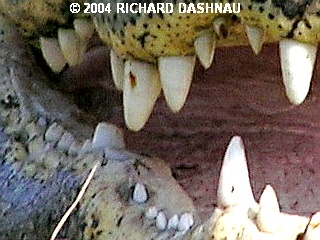
GAPE
FROM
THE
FRONT
NEW TEETH FROM FRONT
In the
closeups, it's possible to see that many teeth are apparently
missing.
This could be from crushing the turtle's shell
last
week. For an alligator, this is not a major disaster, because
alligator
teeth grow in a sort of nested stack. That is, an
exposed
tooth has another tooth growing right underneath it; and the tip
of this
new tooth actually fits snugly into
the
base of the outer tooth. When a tooth is knocked out, there is
another
one, ready to use, right underneath. In the closest
views,
you can see the tips of the new teeth in the jaws. I show a single
tooth,
with a nested mate, in the three pictures below (see ALLIGATOR
TEETH NESTED,
TEETH TOGETHER, and
SEPARATED). Notice how the bases of both teeth are
hollow.
Also
among the alligators enjoying the mild weather was a pod of babies
near
their mother. Unfortunately, this was during early
afternoon, and the sun
was so bright it was hard to get a decent picture. I did get this
one,
though of a baby alligator
a fairly
safe position. See THE BABY RIDES, below right.
---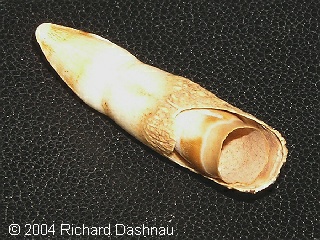 --
--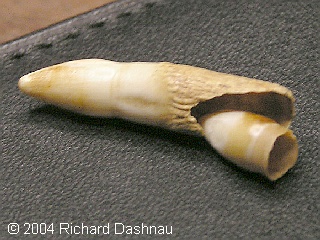 --
--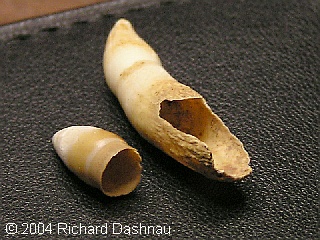 -
-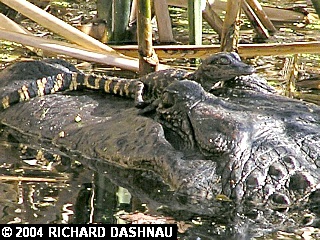 -
-
ALLIGATOR TEETH NESTED
ALLIGATOR
TEETH TOGETHER
ALLIGATOR TEETH
SEPARATED
THE BABY RIDES
December
26, 2004
Yes. It is snow. Many of us in the area got to see snow and/or
sleet in
various quantities on Christmas Eve. However, areas nearer
the coast
got a lot of snow. Brazos
Bend State Park apparently recieved 5 inches
of snow. For those of you that don't live here (like up in the
"frozen
North"--HA! How are you and your wife doing, Dylan?), please
understand
that
the last time some of the affected areas saw snow of this
magnitude
was over TWENTY YEARS AGO! We don't get snow here.
I didn't
go out to the park on Christmas day, when the snow was
fresh, but there
was some left for me to see Sunday.
The
image below (WHITE STUFF!) shows the first bench I came to after I
left
the parking lot. The first image below (40ACRE ENTRANCE) shows the
same
bench from the other side. When I got
to the fork in the trail, I
looked towards the parking lot, and took a picture of the sun
shining through
the haze. (see 40ACRE PARKING, below) At the edge of 40 Acre Lake,
the
bench at the end
of the Hoot's Hollow trail had a lot of snow around it
(see HOOT'S HOLLOW, below).
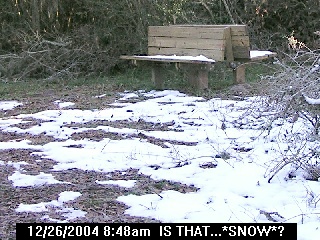 -
-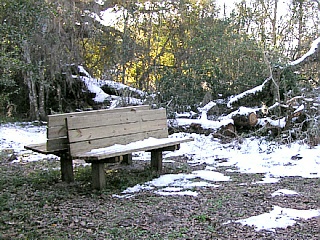 --
--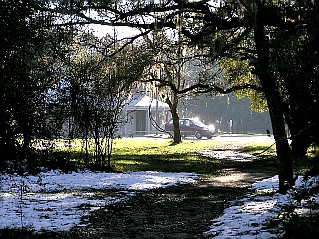 --
--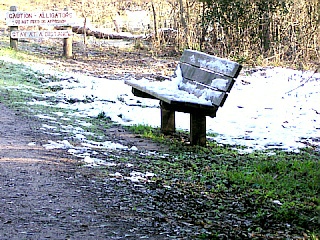 --
--
WHITE
STUFF!
40ACRE
TRAIL ENTRANCE LOOKING AT 40ACRE
PARKING
BENCH BY HOOT'S HOLLOW
As I
walked towards the Observation Tower, I noticed a very slight skin
of ice
on parts of both Pilant and 40 Acre Lakes. When I got to the
Observation
Tower, I looked at the short wooden bridge,
starting to compose a shot,
when I caught movement off to my right. itOn
the
left side of the trail I saw snow. On the right side of the trail,
near the bridge, I saw...AN ALLIGATOR! (See SNOW!?
WHAT'S UP WITH THAT?,
below) It was still cold enough for me to be bundled up, and here
was this
alligator swimming. There was no ice in the water there. Also, it
moved
quickly into the
weeds, before I could even get another picture.
This was at about 9:00 am.
-- -
- 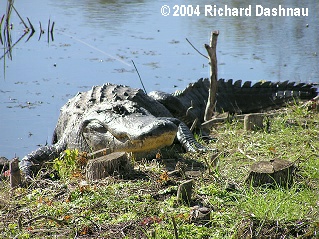 --
--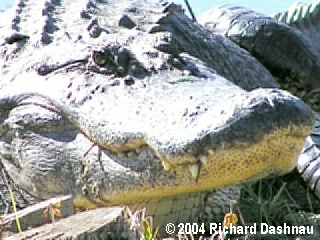
SNOW!? WHAT'S UP WITH THAT?
WHERE'RE MY PRESENTS?
MAYBE YOU DIDN'T HEAR ME
Later,
I walked to New Horseshoe lake, where, at about 10:30, I saw a big
alligator
up on the bank. (see WHERE'RE MY PRESENTS?, and MAYBE YOU DIDN'T,
above).
Any day I get to see
alligators is a good one for me; and the last thing
I expected to see at BBSP was snow and alligators on the same day.
FEBRUARY
20, 2005 What the heck....it's long past time for an
alligator. So...here
you go! I was looking at a small pod of baby alligators at Elm
Lakewhen
a park visitor came by. While I was
talking about the babies, I kept hearing
a crackling noise behind me. When I stopped talking to look, the
noise
stopped. Then I'd talk some more, and I'd hear a branch snap.
Finally,
I heard the
noise, and looked, and an alligator was making its way up from
Pilant Lake. I told the park visitor (from Wisconsin, if I recall
correctly.
I hope they enjoyed their visit.) that the alligator would most
likely
rest for about 5 minutes, and then cross the trail to Elm
Lake. So,
the visitor sat on the bench to see what would happen. I
think it
was closer to 10 minutes' rest, but the alligator did begin
walking. The
bench is actually at least 10 feet behind the alligator. I shot a
few burst
sequences. This is the first one. (see ONE STEP PART 1 to 5,
below). I
was able to note that the eye facing
me was bad, with a brownish cast or
covering apparent on it. I wasn't able to get a good closeup shot
of this
bad eye, though.
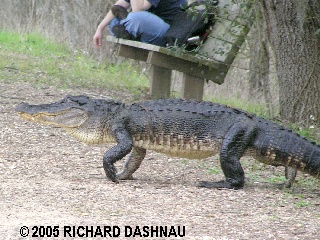 -
- -
-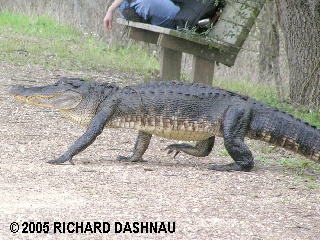 -
-
ONE STEP PART 1
ONE STEP PART
2
ONE STEP PART 3
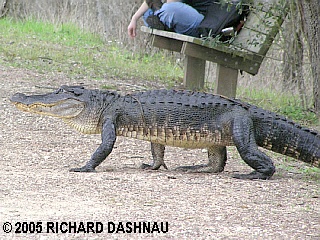 -
-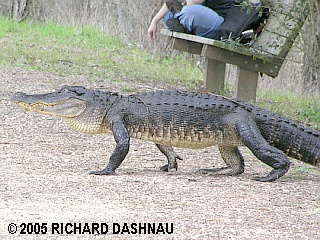
ONE
STEP
PART
4
ONE STEP PART 5
It got
most of the way across the trail, took another brief rest, and
then walked
the rest of the way into Elm Lake. I had time to change to video
mode on
the camera and shot one clip. (See TO
THE WATER, below).
-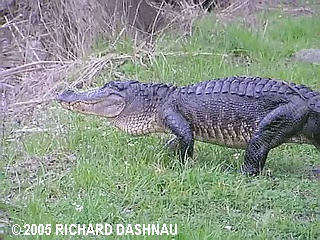 ---
---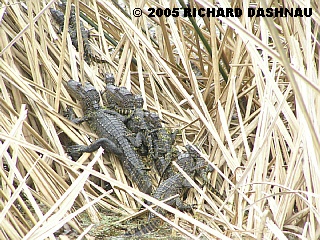 --
-- ---
---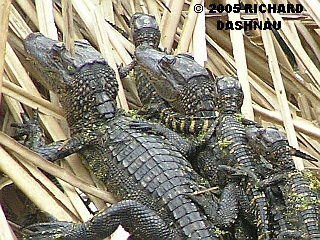
TO THE
WATER!
BABIES
ON RICE
BABIES ON RICE CLOSER
OLDER
SIBLINGS?
VIDEO CLIP 620KB
And
what about the babies? Well, here they are. (see BABIES ON
RICE, above).
There was an alligator on the bank nearby, which everyone
assumed was the
mother. The day was overcast, with little sun, but the
temperatures were
in the 70's. Look closely at the pictures of the baby
alligators,
and you will see quite a size
difference between them. The smallest were
probably hatched last year. The others, could be a year old,
and some of
the bigger ones could even be older!
And,
this page shows alligators at the park, on
land, near various landmarks at the park.
Go back to my main alligator
page, Alligators
Go
back to my home page, Welcome
to rickubis.com
Go
back
to the RICKUBISCAM
page.
Go
back
to the See the
World
page.
 -----
----- ------
-
------
-


























